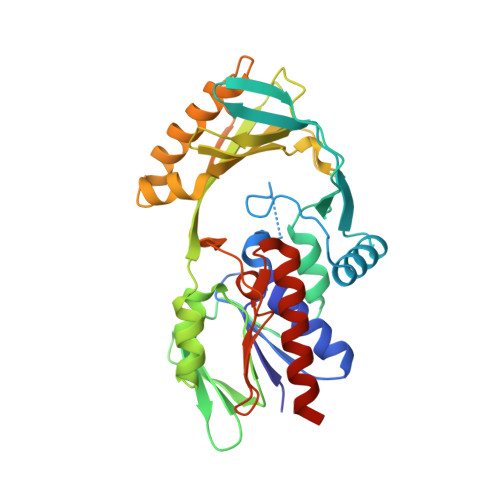Ligand binding phenomena that pertain to the metabolic function of renalase.
Beaupre, B.A., Roman, J.V., Hoag, M.R., Meneely, K.M., Silvaggi, N.R., Lamb, A.L., Moran, G.R.(2016) Arch Biochem Biophys 612: 46-56
- PubMed: 27769837
- DOI: https://doi.org/10.1016/j.abb.2016.10.011
- Primary Citation of Related Structures:
5KKA, 5KKC, 5KRQ - PubMed Abstract:
Renalase catalyzes the oxidation of isomers of β-NAD(P)H that carry the hydride in the 2 or 6 positions of the nicotinamide base to form β-NAD(P) + . This activity is thought to alleviate inhibition of multiple β-NAD(P)-dependent enzymes of primary and secondary metabolism by these isomers. Here we present evidence for a variety of ligand binding phenomena relevant to the function of renalase. We offer evidence of the potential for primary metabolism inhibition with structures of malate dehydrogenase and lactate dehydrogenase bound to the 6-dihydroNAD isomer. The previously observed preference of renalase from Pseudomonas for NAD-derived substrates over those derived from NADP is accounted for by the structure of the enzyme in complex with NADPH. We also show that nicotinamide nucleosides and mononucleotides reduced in the 2- and 6-positions are renalase substrates, but bind weakly. A seven-fold enhancement of acquisition (k red /K d ) for 6-dihydronicotinamide riboside was observed for human renalase in the presence of ADP. However, generally the addition of complement ligands, AMP for mononucleotide or ADP for nucleoside substrates, did not enhance the reductive half-reaction. Non-substrate nicotinamide nucleosides or nucleotides bind weakly suggesting that only β-NADH and β-NADPH compete with dinucleotide substrates for access to the active site.
- Department of Chemistry and Biochemistry, University of Wisconsin-Milwaukee, 3210 N. Cramer St, Milwaukee, WI, 53211-3209, United States.
Organizational Affiliation:


















